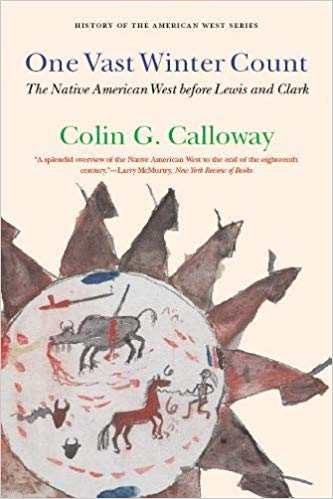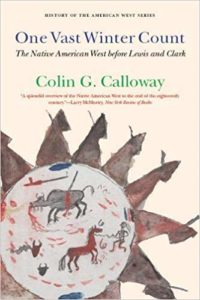Their Stories Are Our Story

With the publication of its initial volume, the University of Nebraska’s History of the American West series is off to a fantastic start. Series editor Richard Etulain promises several volumes that will offer fresh and comprehensive interpretations of the American West to general readers and specialists alike. One Vast Winter Count is written by a scholar with years of experience teaching American Indian history and motivating others to join the endeavor. Behind the creation of this remarkable synthesis, I visualize Colin Calloway digesting volumes and volumes of literature in order to make it all meaningful and current for his students. And while pursuing his own original research and synthesizing the work of others, Calloway moreover knows from extensive personal experience what Native American people are doing and thinking today. He takes no shortcuts to this rich material and considers multiple points of views. Covering long periods and large spaces, Calloway wisely selects particular groups, regions, and events in order to illustrate important experiences and themes. He treats readers to scholarly debates over how to interpret evidence of American Indian life across the West, but weaves Native American traditions and meanings into the narrative wherever possible. Landscapes of ancient sites, natural features, and human memories are treated as historical texts, the winter count used by Plains peoples inspiring the book’s title. We are reminded that “knowledge of the West was already there,” before European explorers and colonizers entered the stories (11).
Calloway acknowledges that usage of “the West” is problematic, pointing out how it refers to different places according to one’s position on the continent. In order to encompass all relevant events and processes, he includes the region between the Appalachian Mountains and the Mississippi River. Most of this book’s attention, however, is directed to Native American peoples west of the Mississippi. Anticipating the impending relationship between western Indians and the United States, Calloway turns the table on common assumptions about the “American West.” “The West has always been a region of movement and migration, of peopling and repeopling; this was so in the fourteenth and eighteenth centuries as it still is in the twenty-first. For hundreds of years, Indian peoples explored, pioneered, settled, and shaped the West” (17). In other words, Indian country was not a dormant land waiting for Euro-Americans to set things in motion. Calloway asks us to begin rethinking recent centuries in the West as “part of an ongoing American saga rather than just the culmination of Europe’s westward adventure” (18). The exceptionalism of American history is thereby brought into question, with a somewhat ominous message. “Only by considering America as Indian country can we get a sufficiently long span of history to recognize that civilizations here have risen and fallen as they have elsewhere in the world” (20).
Part I, “The West before 1500,” contains two chapters that effectively summarize thousands of years. Calloway introduces the reader to the most up-to-date findings and interpretations in archaeology, but orients his own analysis around the theme of movement. While they migrated and adapted to new environments, as shown in chapter 1, hunting and gathering pioneers laid regional foundations for cultural traditions and social structures. Calloway characterizes the Native American West as a “kaleidoscope of population movements and interactions” (56). Such motion across fluid boundaries, he suggests, cannot be properly captured in words like “phases,” “traditions,” and “complexes” so commonly used by archaeologists.
Chapter 2 traces the spread of corn agriculture across the continent. Although Native Americans developed seven hundred species of corn and the plant played a key role in the expansion of European colonies, this history was later submerged by United States officials who ironically “insisted that Indian people give up their old ways of life and become farmers” (115). Calloway identifies both the advantages and disadvantages brought by some societies’ dependence upon domesticated plants. Environmental stress and population density posed new challenges, which American Indians faced with versatility. “The ruins preserved in the dry climate of the Southwest create an illusion of sudden and catastrophic abandonment,” but Calloway argues that this perception overlooks less dramatic, but successful strategies deployed by American Indians as they migrated from high-risk locations and reassembled in other areas. “People made choices based on the alternatives available; they knew where they were going and why, and their decisions to move involved both ‘push’ and ‘pull’ factors” (91). In explaining change and continuity among agrarian societies in the Southwest and the Eastern Woodland, he notes the importance of movement as an idea in the people’s own origin histories, “whether from lower to upper worlds or from place to place” (92).
Calloway pulls together the years from 1500 to 1730 into three chapters comprising the second part of this book, “Invaders South and North.” Chapters 3 and 4 focus on Southwestern Indians’ struggles against Spanish colonialism over the sixteenth and seventeenth centuries. Religions that sustained native societies fell under siege, and resistance to domination was widespread and influential. Calloway situates the Pueblo Revolt of 1680 within the larger framework of a “Great Northern Rebellion.” During the 1680s and 1690s, many wars of independence were being waged across the northern frontier of New Spain by Conchos, Tarahumaras, Mansos, Sanos, Pimas, Opatas, and Apaches. Thanks to Calloway’s attentiveness to new collections and interpretations of neglected documents, readers will also find here a compelling treatment of the protracted and tumultuous reconquest of New Mexico by Spanish forces. Calloway completes Part II with a chapter on Indian relations with the French Empire. While leaving us with the impression of how precarious, even perilous, the Spanish presence was in the Southwest, he portrays French interaction with Native Americans as ambiguous and complex. The Great Lakes and Mississippi Valley witnessed a great deal of cooperation and accommodation, but were not spared conflict and bloodshed.
The narrative force of Calloway’s synthesis escalates in the three chapters that comprise Part III, “Winning and Losing in the West, 1700-1800.” Chapter 6 explores the impact of the horse on the American West. In a process comparable to the spread of corn hundreds of years earlier, Indian people changed their worldview, organization, and daily life as “pedestrians became equestrians” (267). Calloway traces the routes of exchange and raiding by which horsemanship reached one nation after another, while also delving into how particular societies adapted to the opportunities and challenges posed by horses. With all of the changes chronicled thus far, nothing compares with those examined in chapters 7 and 8 of One Vast Winter Count. As the “tentacles of European empires began to reach deep into the Indian West,” homelands were transformed into borderlands. But Calloway argues in chapter 7 that Europeans were people “on the edge” of Indian territories as much as Native Americans were “in between” European empires (331). Indian peoples became involved in intense European rivalry, some faring better than others, yet many were still able to shape the terms of these imperial contests. Then, “world war” came to the Ohio Valley and was quickly followed by native and colonial wars against empire. The reverberations were even felt west of Mississippi.
Chapter 8 captures all of the revolutionary changes that made the American West in 1803 “a very different place from what it had been just a generation earlier” (426). Many Native American societies were terribly ravaged by the smallpox epidemic of 1779-83. Maritime trade on the Northwest Coast established a United States presence in the far West before the arrival of Meriwether Lewis and William Clark. Across widening areas, meanwhile, Spanish and American officials attempted to regulate relations with Indian nations and reduce conflict on volatile frontiers.
Colin Calloway delivers two timely messages in the epilogue. First of all, cultural mixings generated by earlier imperial efforts had shaped the West long before the United States claimed it. Secondly, the history of Native Americans in the West is not simply a prelude to American history. “Their stories are our story,” he declares, and “they made choices that made sense at the time they made them but with long-term consequences they could not foresee” (433). This much longer human history of the West informs more recent manifestations of power and prosperity on the land. “We are adding our symbols, but the spiraling calendar continues” (434).
This article first appeared in issue 4.3 (April, 2004).
Daniel Usner is Holland McTyeire Professor of History at Vanderbilt University, currently completing a book on frontier Mississippi at the Huntington Library.
